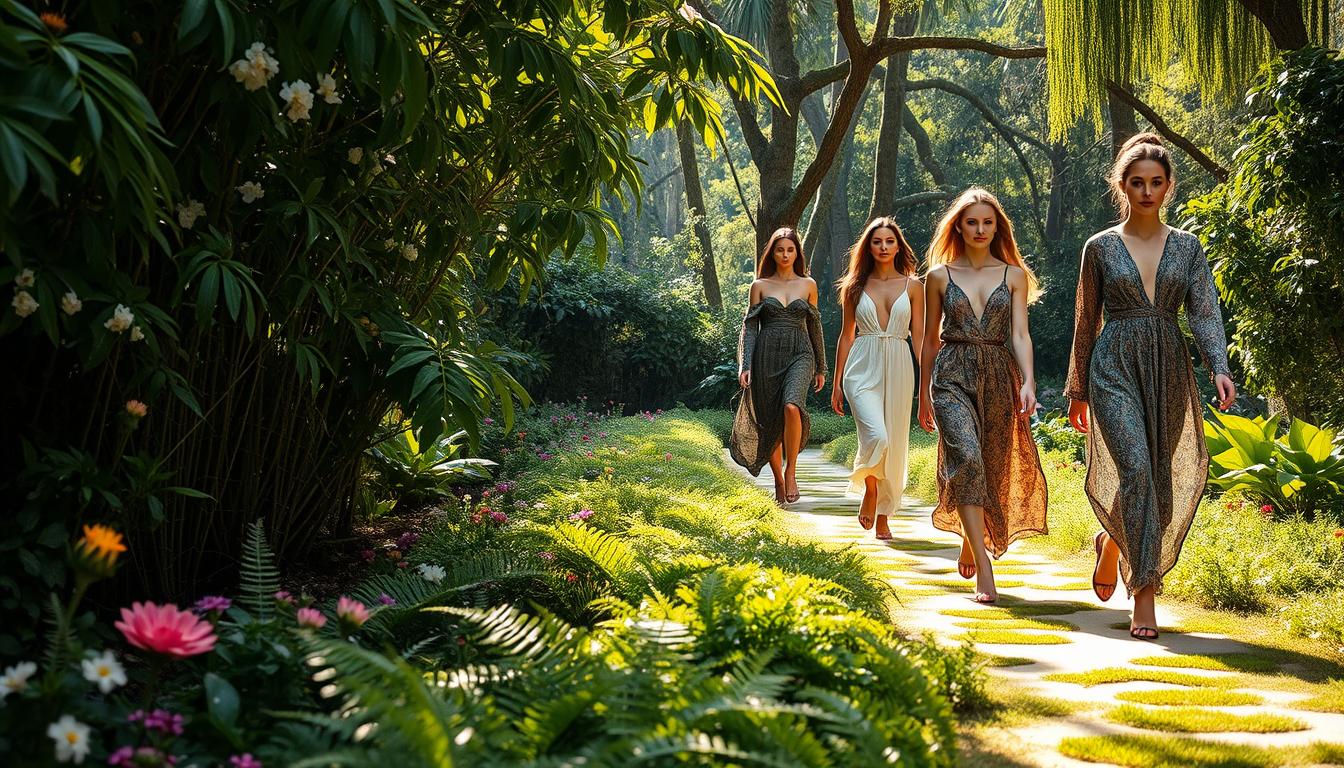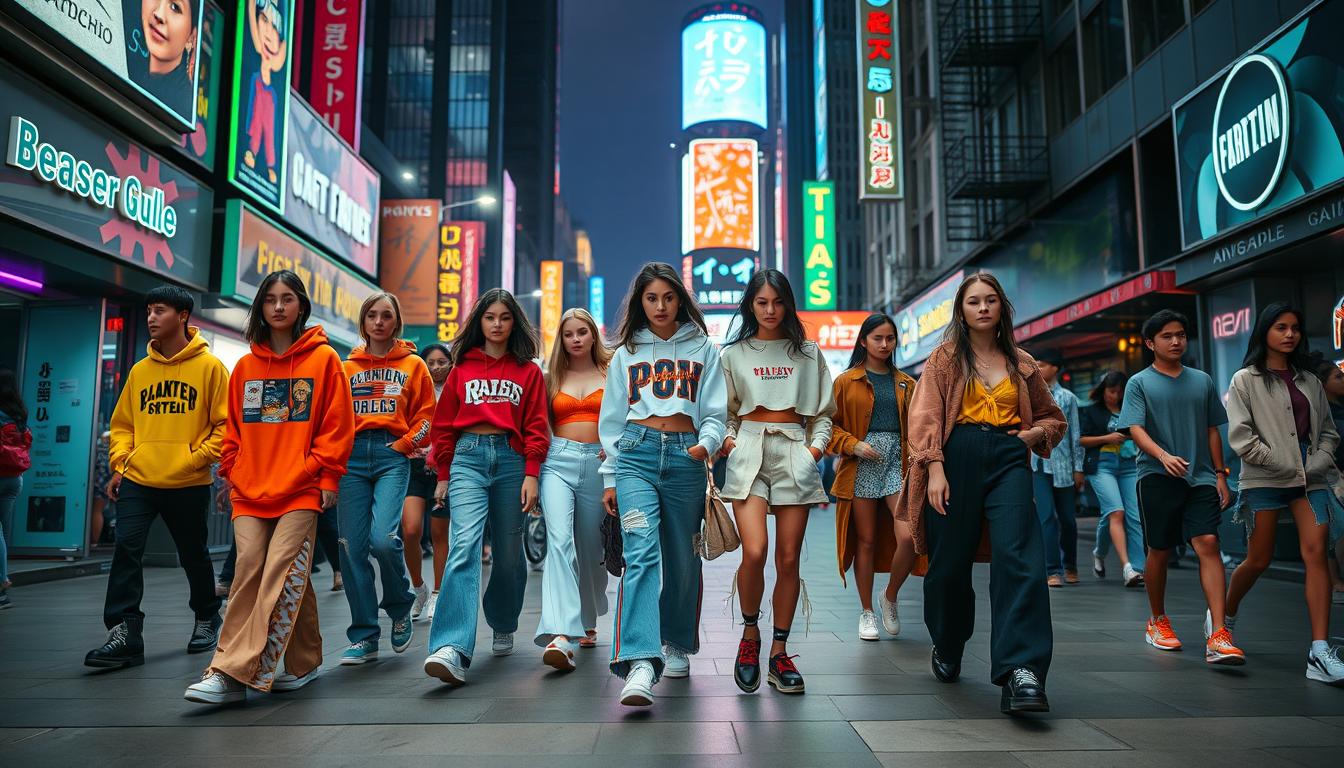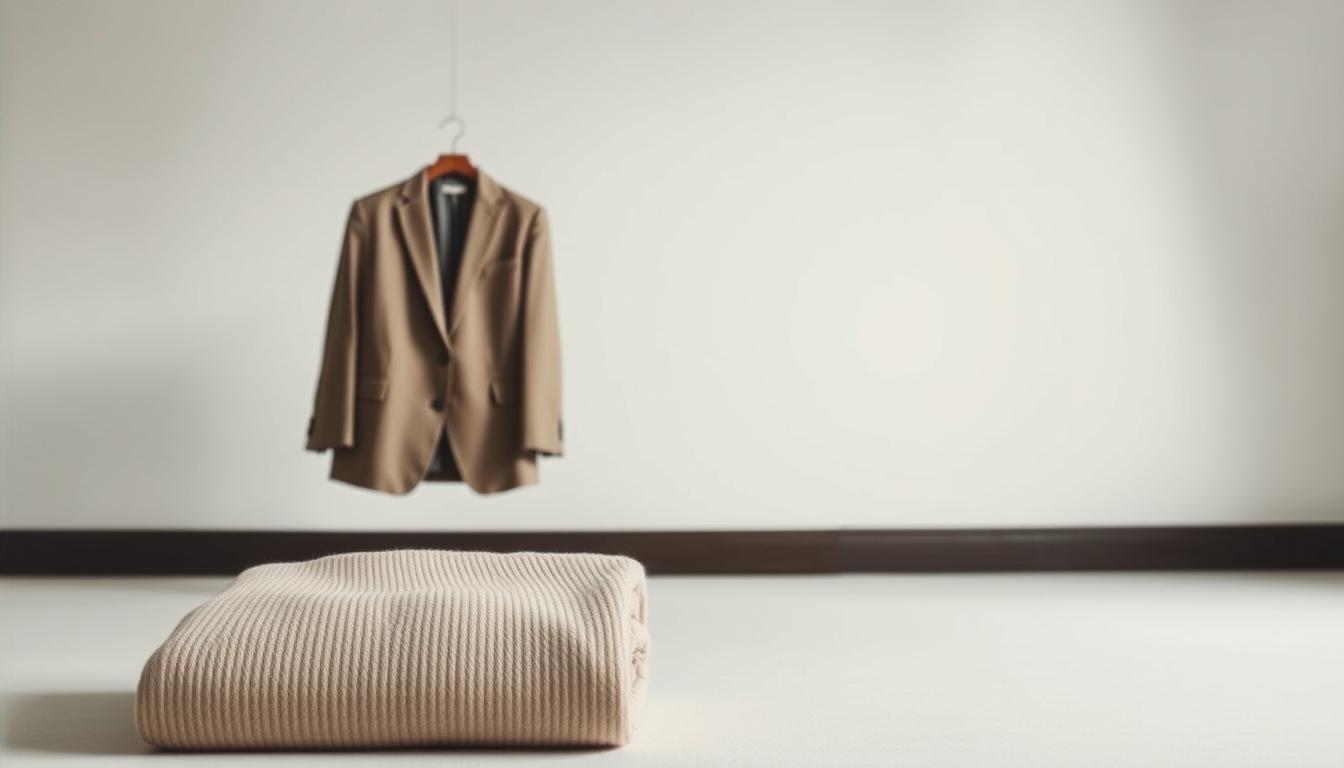As we enter 2025, fashion is changing a lot. People now care more about the environment and fair practices. They want to know how their clothes affect the planet.
There’s a big need for ethical style tips today. More people want to buy clothes that are good for the earth. The fashion world is starting to use recycled stuff, cut down on waste, and treat workers fairly.
Choosing eco-friendly fashion in 2025 is both smart and stylish. New designs and materials let you look great while helping the planet.
Key Takeaways
- Embracing eco-friendly fashion is crucial in 2025.
- Ethical style tips are essential for responsible fashion choices.
- The fashion industry is shifting towards more sustainable practices.
- Eco-friendly fashion is a stylish and moral choice.
- Innovative designs and materials are driving the eco-friendly fashion movement.
The State of Sustainable Fashion in2025
The year 2025 is a big moment for sustainable fashion. New ideas and more people knowing about them are changing things. The fashion world is working hard to be better for the planet, and new trends are starting to show.
Key Innovations Reshaping the Fashion Landscape
The fashion world is getting a big tech boost. This is making things more sustainable. Material science and making supply chains clear are leading the way.
Material Science Breakthroughs
New, green materials are being made. They work better and are good for the planet. For example, biodegradable synthetics are getting popular. They help make fashion products less harmful.
Supply Chain Transparency Technologies
Tools like blockchain are making supply chains clearer. This lets people know where their clothes come from. It helps make sure clothes are made right.
Consumer Behavior Shifts Driving Change
People’s buying habits are also changing fashion. More people now think about how their choices affect the planet and people. This is pushing fashion towards being more eco-friendly.
| Trend | Description | Impact |
|---|---|---|
| Increased demand for eco-friendly products | Consumers are seeking products made from sustainable materials. | Drives innovation in material science. |
| Rise of circular fashion | Consumers are embracing clothing rental and second-hand shopping. | Reduces waste and supports sustainable consumption. |
| Transparency and accountability | Consumers expect brands to be transparent about their supply chains. | Promotes ethical production practices. |
As people keep asking for sustainable fashion, the industry is coming up with new answers. It’s getting more open too. This change will keep shaping fashion in 2025 and after.
Sustainable Fashion Trends That Don’t Sacrifice Style
The latest trends in sustainable fashion are changing the game. They show that you can look great without harming the planet. Fashion brands are now using new materials and methods that are both stylish and eco-friendly.
Regenerative and Carbon-Negative Materials
Regenerative materials are becoming more popular. They not only cut down on environmental harm but also help nature. Algae-based fabrics and mycelium leather are two examples.
Algae-Based Fabrics and Applications
Algae-based fabrics use algae to create sustainable, biodegradable materials. They are eco-friendly and have unique textures. These fabrics are used in everything from high-end clothes to sports wear.
Mycelium Leather Alternatives
Mycelium leather is a new innovation. It’s made from mushroom roots and looks and feels like leather but is better for the planet. It’s used in luxury items like handbags and shoes.
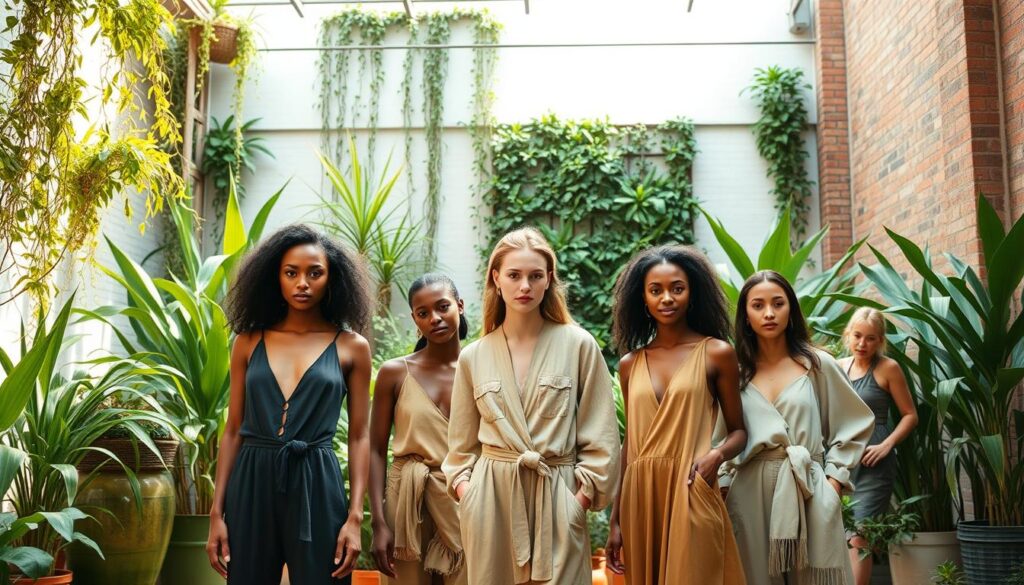
Biodegradable Synthetics and Performance Wear
Biodegradable synthetics are changing activewear. They are strong and good for the environment. They break down easily, reducing plastic pollution. Brands are adding these materials to their sportswear, making eco-friendly fashion more available.
Circular Design Principles in Everyday Fashion
Circular design is making everyday fashion more sustainable. It encourages the reuse and recycling of clothes. Brands are designing clothes that can be recycled or upcycled, reducing waste.
Some key features of circular design include:
- Designing for recyclability
- Using recycled materials
- Creating garments that can be easily repaired or upcycled
By following these trends, we can enjoy stylish, quality clothes while helping the planet.
How to Decode Sustainable Fashion Certifications
With eco-friendly fashion on the rise in 2025, knowing about sustainable fashion certifications is key. It’s important for making smart choices when you shop.
Next-Generation Eco Labels to Look For
Several eco-labels are leading the way in sustainable fashion. Some top ones include:
- Bluesign: Makes sure textiles are safe and good for the environment.
- GOTS (Global Organic Textile Standard): Checks if textiles are organic and made in a green way.
- Oeko-Tex: Focuses on keeping people and the planet safe from harmful textiles.
These labels mean a product has passed tough tests for being green and safe.
Digital Passport Systems for Garment Traceability
Digital passport systems are changing how we track clothes. They give us info on a product’s whole life, like:
- Where the materials come from
- How it was made
- How it got to you
Brands like Patagonia and Reformation are using digital passports to be more open.
Avoiding Greenwashing in the 2025 Marketplace
To dodge greenwashing, look beyond what companies say. Check for:
- Third-party certifications
- Clear supply chains
- Reports on how it affects the environment
By staying informed and careful, we can help make fashion more sustainable.
Creating Your Ethical Capsule Wardrobe Step-by-Step
Starting an ethical capsule wardrobe helps reduce fashion waste. It makes choosing clothes easier and supports a greener future.
Assessing Your Current Wardrobe Sustainability
First, check out your current clothes. Find items you wear often and that fit your style. Think about their environmental and social impact too.
- Sort clothes into categories (e.g., tops, bottoms, dresses).
- Check each item’s condition and quality.
- Look into the brand’s ethics and sustainability.
Essential Eco-Friendly Pieces Worth Investing In
Choosing eco-friendly pieces is key for an ethical wardrobe. Look for items that are both stylish and good for the planet.
Versatile Basics with Extended Lifecycles
Invest in basics like a classic white shirt or a tailored pair of trousers. Choose sustainable materials like organic cotton or recycled fibers.
Statement Pieces from Ethical Sources
Statement pieces can make your wardrobe pop. Choose items from brands that focus on ethical production and fair labor.
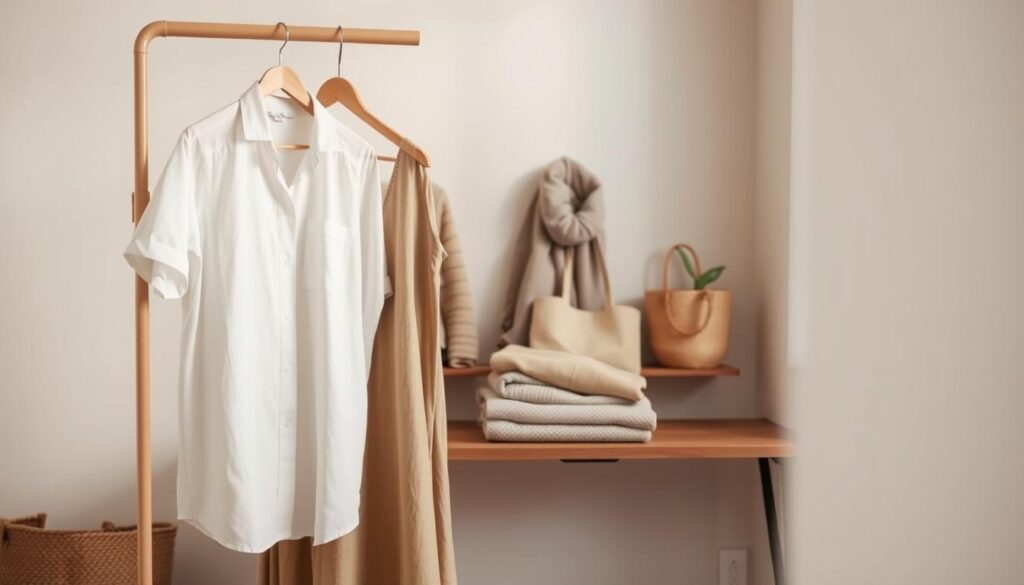
Styling Techniques for Maximum Versatility
To get the most out of your capsule wardrobe, try different styling tricks.
| Styling Technique | Description | Example |
|---|---|---|
| Layering | Combining multiple pieces to create a new look. | Pairing a t-shirt with a sweater and jeans. |
| Accessorizing | Adding accessories to enhance an outfit. | Adding a belt to cinch a dress. |
| Mixing and Matching | Creating new outfits by combining different pieces. | Pairing different tops with the same bottom. |
By following these steps and techniques, you can build a stylish and ethical capsule wardrobe. This supports a more sustainable fashion world.
Tech-Integrated Sustainable Fashion Solutions
The fashion world is changing fast, thanks to tech. We’re seeing new products and services that are good for the planet and better for us. These innovations are making fashion more sustainable and enjoyable.
AI-Powered Personal Styling for Reduced Consumption
Artificial intelligence is changing how we shop for clothes. It gives us personalized advice to help us buy less. AI-powered styling tools look at what we like and our lifestyle. They suggest outfits and pieces that can be mixed and matched, cutting down on waste.
Blockchain Verification of Ethical Production
Blockchain technology is making fashion more transparent. It shows where our clothes come from and how they’re made. This tech fights fake products and ensures fair labor conditions.
Smart Textiles with Extended Lifespans
Technology is also making fabrics last longer. Smart textiles are designed to be durable and adaptable. They can even clean themselves, saving water and energy.
Self-Cleaning Fabrics
Self-cleaning fabrics use nanotechnology to fight stains and smells. This means we wash them less, saving resources and making clothes last longer.
Adaptable Garments That Grow With You
Some clothes can change with us. They grow or adjust to fit our changing needs. This is great for kids’ clothes that can grow with them.
Practical Guide to Sustainable Shopping on Any Budget
Now, you can choose eco-friendly fashion without spending a lot. Sustainable shopping means picking items that are stylish, well-made, and good for the planet.
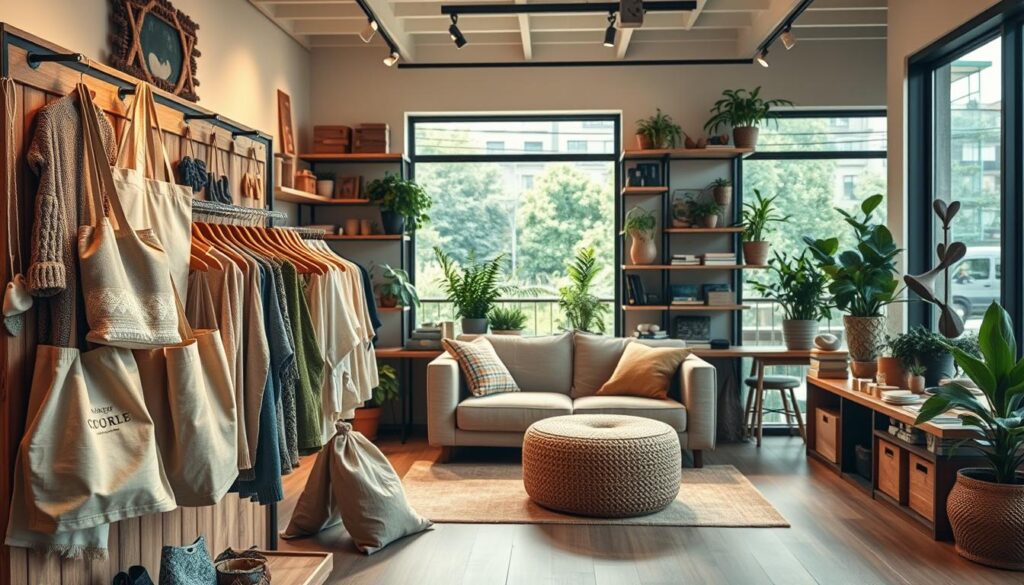
Digital Thrifting Platforms and Authentication Tools
Digital thrifting has changed how we shop green. Websites and apps have lots of second-hand items. This makes it easy to find unique clothes and cut down on waste. Tools that check if items are real help avoid scams.
Some top digital thrifting sites are:
- The RealReal
- ThredUp
- Depop
These sites help you update your style without spending a lot. They’re great for the planet too.
Rental Subscriptions and Peer-to-Peer Sharing
Fashion rental is a smart choice for saving money and the environment. It lets you wear high-quality clothes for less, cutting down on waste.
“Fashion rental is not just about saving money; it’s about reducing the environmental impact of our wardrobe choices.” – Fashion Industry Expert
Sharing clothes with others also helps the planet. It makes fashion more circular and sustainable.
Investment Strategies for Ethical Fashion Pieces
Buying ethical fashion needs careful thought. Think about the item’s cost and how long it will last.
Cost-Per-Wear Calculations
Figuring out the cost-per-wear is a smart way to judge a purchase. It’s the item’s price divided by how many times you’ll wear it.
| Item | Initial Cost | Number of Wears | Cost-Per-Wear |
|---|---|---|---|
| Eco-friendly dress | $100 | 20 | $5 |
| Sustainable jeans | $80 | 50 | $1.60 |
Resale Value Considerations
Think about how much an item will be worth later. Quality pieces often keep their value or even go up.
By using these tips, you can shop green and stay within your budget.
DIY Upcycling Techniques for2025 Style
In 2025, DIY upcycling is more than a trend. It’s a lifestyle that blends sustainability with style. As people care more about the environment, they seek creative, eco-friendly ways to update their wardrobes.
Digital Pattern Libraries and Customization
Digital tools have made upcycling easier and more fun. Digital pattern libraries let you create unique, customized pieces. These libraries are online, giving you the chance to try out different patterns and designs.
Platforms like Adobe and Etsy offer these libraries. They spark creativity and teach you how to make your upcycling projects come to life.
Step-by-Step Garment Transformation Projects
Turning old clothes into new, stylish items is rewarding. Here are some projects to get you started:
- Upcycle old jeans into trendy shorts or a denim jacket.
- Turn vintage shirts into reusable tote bags.
- Convert outdated dresses into modern skirts or tops.
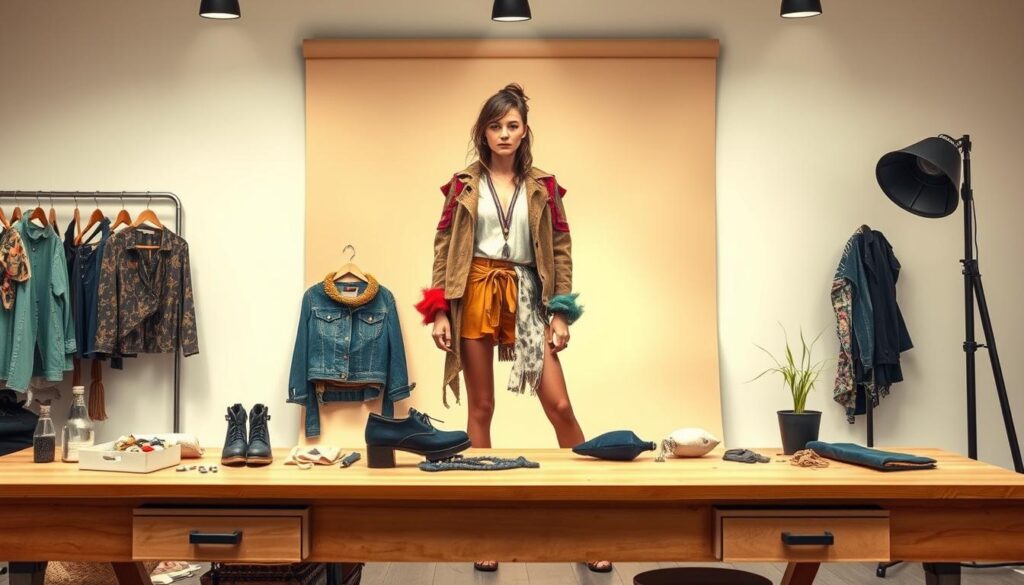
For beginners, learning basic sewing and modification skills is key. This includes altering hems, replacing buttons, and making simple repairs. Online tutorials and workshops can help you get hands-on experience.
Advanced Upcycling for Statement Pieces
If you want to create unique statement pieces, try advanced techniques. These include embroidery, patchwork, and fabric manipulation. They require skill and patience but lead to truly one-of-a-kind creations.
Community Skill-Sharing Resources
The upcycling community is full of resources for sharing skills. Online forums, social media groups, and local workshops are great places to learn, share, and show off your projects. Being part of these communities can spark new ideas and keep your skills sharp.
Check out YouTube for tutorial videos and social media groups focused on sustainable fashion and upcycling.
Sustainable Accessories and Footwear Revolution
The future of fashion accessories and footwear is changing for the better. Sustainable practices and eco-friendly materials are leading the way. Now, consumers can find innovative products that are good for the planet and stylish.
Compostable Jewelry and Accessories
Compostable jewelry is a big deal in sustainable accessories. Brands are making pieces from biodegradable materials like plant-based bioplastics and recycled metals. Patagonia and Stella McCartney are leading the way with their eco-friendly designs.
Zero-Waste Footwear Construction Methods
The footwear industry is moving towards zero-waste methods. Shoes are now designed to use less material, thanks to 3D knitting or molding. Nike and Adidas are leading this change to cut down on waste.
3D-Printed Custom Accessories with Recycled Materials
3D printing is making custom accessories from recycled materials. This approach cuts down on waste and lets people create unique items. There are two main ways to use 3D printing for this:
Home Printing Options
Home printing options are getting better. Now, people can make their own accessories using recycled materials. This supports a circular economy and reduces the need for transportation.
On-Demand Manufacturing Services
On-demand manufacturing is another 3D printing benefit. Companies can make items only when they’re ordered. This cuts down on storage needs and waste.
| Material | Traditional Use | Sustainable Alternative |
|---|---|---|
| Plastic | Jewelry and buckles | Bioplastics or recycled plastics |
| Leather | Footwear and belts | Vegan leather or recycled leather |
| Metal | Jewelry and zippers | Recycled metals |
The sustainable accessories and footwear movement is growing fast. Now, people can choose eco-friendly options without giving up style or quality.
Maintaining Your Ethical Wardrobe for Longevity
Sustainable fashion is more than just buying eco-friendly clothes. It’s also about taking care of what you have. By properly caring for your ethical wardrobe, you can make your clothes last longer. This reduces the need to buy new clothes often, which helps the environment.
Water and Energy-Efficient Care Techniques
One easy way to care for your clothes is to use water and energy wisely. Wash clothes in cold water, dry them outside, and use green detergents. These steps save resources and keep your clothes looking good.
Repair Services and DIY Maintenance
Keeping your clothes in good shape is important. Simple fixes like sewing on buttons or mending seams can be done at home. If you know how to sew a bit, you can extend your clothes’ life.
Essential Mending Skills
- Basic sewing stitches
- Patching torn fabric
- Darning socks
Professional Restoration Options
For bigger repairs, it’s best to get help from a pro. Many ethical brands offer repair services, or you can find a local tailor. Getting your clothes fixed by a professional can make them last even longer.
End-of-Life Planning for Different Materials
Even with good care, clothes will eventually wear out. It’s important to plan what to do with them then. Organic cotton can be composted, while recycled polyester might have special recycling options.
| Material | End-of-Life Option | Environmental Impact |
|---|---|---|
| Organic Cotton | Composting | Low |
| Recycled Polyester | Recycling Programs | Moderate |
| Synthetic Blends | Specialized Recycling | High |
Conclusion: Embracing Ethical Style in a Changing World
In today’s world, caring for the environment is key. Ethical style is now a must, not just a choice. The fashion world is changing, with a focus on sustainable fashion leading the way.
By following the tips in this article, we can pick clothes that are good for our planet. This way, we can make our wardrobes better and help the environment at the same time.
The path to a greener fashion industry is long, but we’re making progress. New materials and ways to make clothes are being found all the time. When we choose to buy ethically, we help brands that care about the planet.
Our choices can really make a difference. By choosing sustainable fashion, we push the industry towards a better future. Fashion is not just about looks anymore. It’s about being fair and kind to our planet.
Looking ahead, ethical style and sustainable fashion will keep shaping the fashion world. They offer a way to dress responsibly and with awareness. As we move towards 2025 and beyond, this approach will become even more important.

